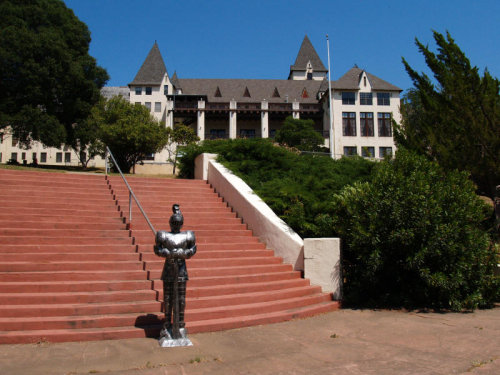- Roberta Actor-Thomas
- Posted On
Actor-Thomas: Is Clearlake capable of doing due diligence on Provensalia?
As a volunteer member of the neighborhood council’s land use committee, I listened to scores of proposals by dozens of developers. Some were good projects that added value to the community and improved the business environment and some were not.
Back in 2004, a Las Vegas developer, backed by a corporation in Arlington, Texas, proposed a large gated community on 900 acres of beautiful but rugged undeveloped hillside. He hired a major law firm and numerous consultants to lobby the City of Los Angeles for a zone change and a general plan amendment. There was heated opposition, but citizens didn’t stand a chance against this array of legal and financial firepower – he got his subdivision in a supposedly protected Scenic corridor, in violation of an existing specific plan that citizens had written and which the city had approved to prevent this exact sort of thing.
His plan – to put in the roads and infrastructure and sell the subdivision’s parcels off individually or in small groups to other developers!
Provensalia’s unfolding has been like “déjà vu all over again” for us. Our property is in Big Valley, some distance from the site, but we have been following this for several years. Local residents are pointing to many obvious and alarming red flags, but the Clearlake Planning Commission and Clearlake City Council seem to be unaware that it is their job is to comprehend the consequences and costs if they make the wrong decision. Aren’t they concerned about potential financial fallout from this project? This could affect all Lake County taxpayers, but the cost could be thousands of dollars for individual Clearlake property owners and ratepayers if this goes badly.
This doesn’t even start to address planning policy issues or the environmental problems created of this type of development. These are just a few issues that should be causing severe alarm and concern to Clearlake officials, not to mention the residents who will ultimately pay the bill when it comes due.
Unclear ownership?
To recap, Agustin Rosas-Maxemin owns Armax International Inc. with offices in San Francisco and Mexico City. He purchased the property initially but (maybe?) he’s out of the deal now. According to Dick Price, Rosas-Maxemin sold his rights to the project “after Rangel de Alba decided not to have him continue.”
According to the Armax Web site Price is their project manager. He works there, but he talked Jorge Rangel de Alba into buying out his boss? And he's still on the project? www.armax.com/index2a.htm.
Rangel de Alba also “owns units” in an Armax luxury condo project in San Francisco. This may be an “orange” flag. Was this sale really an arm’s length transaction? An arm's length transaction is one in which the parties involved are entirely independent of each other, deal with each other as strangers, and have no reason for collusion.
A family affair
“SF’s fashionable crowd turned out for the opening soirée where a portion of the evening’s sales benefited Raphael House. The family shelter is dedicated to helping at-risk families find stable housing and financial independence, while providing daily comforts and one-on-one support. Celebrants at the party included: Goyard franchise owners Patrick and Luisa Hagemeister-Rangel de Alba, Norman Hagemeister, Jorge Rangel de Alba with his daughter Mariana Hagemeister – the family also owns Bang and Olufsen and Roche Bobois). Goyard owners Alex and Jeanne Signoles flew in from France.” www.newyorksocialdiary.com/socialdiary/2006/08_25_06/socialdiary08_25_06sanfran.php
European Designs owns the stores that sell Goyard, B&O and Roche Bobois. Brothers Norman and Patrick Hagemeister own the franchises for these products and Patrick is the CEO of European Designs. He’s apparently married to Luisa Hagemeister-Rangel de Alba.
Jorge Rangel de Alba is pictured with his daughter, Mariana Hagemeister. Obviously these two families are very closely connected – doesn’t Rangel de Alba “own” the stores?
Implausible ignorance
Recall that Price says he got Rangel de Alba to sell off the additional land originally included in the Provensalia proposal to Starlite Ventures LLC. Starlite Ventures formed on June 15, 2005, and the property was transferred on June 23, 2005, for $2 million. Starlite has no Web site or phone – shell corporations don’t need locations, employees or phones.
Price says he doesn't know who is behind Starlite Ventures. “They made a point of not telling me who it was.” However, Starlite Ventures LLC is apparently Eric Villaseñor and, as noted, Villaseñor is CFO of Hagemeister’s company, European Designs. http://europeandesigns.net/european-designs-about-us.shtml.
This does NOT appear to be an arm’s length transaction – that’s a red flag.
What’s the motive?
Price says he doesn’t believe the parcel sold to Starlite can be developed “due to terrain, trees and lack of an entry.” And “The city’s oak tree ordinance, adopted earlier this year, also would challenge the property’s development ...” Why is Price working so hard to make this point? Why do they want it to look like they “sold” $2 million of “unbuildable” land, which they apparently still own? What’s that about?
Can the Clearlake Planning Commissioners or council members explain what is going on here?
Who is accountable?
Unfortunately, it appears that Rangel de Alba will be more or less untouchable if things go badly for Provensalia and the city of Clearlake. There won’t be much recourse if he doesn’t keep up his side of the sewer deal and anything else Clearlake gets stuck with, but they could try giving him a call at one of his shops on Avenida Presidente Masaryk in Mexico City. http://en.wikipedia.org/wiki/Avenida_Presidente_Masaryk
To give an idea how much money may go through Rangel de Alba’s checking account, he was also a principal in a $190 million merger between two Mexican remittance companies via a shell corporation located in Arlington, Texas. (This transaction can be verified using www.google.com.) However, remittances decline during a recession – this has already been reported in the financial pages of major newspapers like the Wall Street Journal.
Business partner B&O seems to be having their share of troubles, too, according to http://en.wikipedia.org/wiki/Bang_&_Olufsen. In this economy it's anyone's guess how privately-held luxury furniture dealer, Roche Bobois is doing. http://www.rochebobois.com/sites/tendances/index.php?langue=en&pays=us
The Price Group
A number of people have pointed out that the last thing Lake County needs is yet another paper subdivision. Don’t we have enough problems with erosion, illegal dumping, and criminal activities on our existing problem properties?
Dick Price was a principal in Fox Hills, a golf and housing development in Merced – about three quarters of the way down in the Los Banos Enterprise article it mentions the development has NOT “made much visible progress so far.” www.losbanosenterprise.com/114/story/31267.html,
http://foxhillsgolfcommunity.com/html/featured.htm
Price sold off his interest in Fox Hills to some other developers a few years back so maybe he made out okay when the music stopped and everyone ran for the chairs ...
Greater Fool Theory: “Observation that any price (no matter how unrealistic) can be justified if a buyer believes that there is another buyer who will pay an even-higher price for the same item.” ~ www.businessdictionary.com
Here is another red flag of a different sort than Price’s statement that he has no idea who bought that unbuildable parcel – the Price Group’s estimated annual sales revenue is $165,000. He is clearly not in a position to pony up millions for sewers.
www.usadirectlenders.com/pdf/Fox_Hills-Judge_OKs_building_on_protected_ag_land%5B1%5D.pdf
www.manta.com/coms2/dnbcompany_ggj1mm.
Additional oddities
It’s been reported that Rosas-Maxemin also has a development named Provinsalia (with an “i” instead of an “e”) in San Jose. “That Provinsalia consists of 72 hillside homes between 1,500 and 2,000 square feet each – built in a style ‘reminiscent of those found in Provence or Tuscany’ – and ranging in price from $432,000 to $733,700, according to the Armax Web site.” The Yahoo map on the Armax web site links to a parcel next to a development on Sands Drive between a school and another tract development.
By sheer coincidence I was in this neighborhood recently. Nothing I saw bore even a remote resemblance to Provence or Tuscany. The ambiance is better described as “United States of Generica.” You need GPS because every winding suburban street looks exactly like the last one you drove down.
When I called the San Jose offices for Provinsalia, the phone numbers listed on the Web site were disconnected with no new number or rang with no answer. Maybe Provinsalia is 72 condo units on Sands Drive – crammed onto Highway 87 freeway frontage road in the middle of a very built-up area about two miles south of downtown San Jose. I have no plans to return in the near future to verify this. However, you will find that Provinsalia web page VERY difficult to access from the Armax Web site home page and it is not listed on the site map. It’s almost like it’s hidden or been removed or something . . . so here’s the link: http://www.armax.com/projects/provensalia.htm.
Conclusion
No case has been made that this project will result in a gain for Clearlake, rather than merely a profit for the developer upon sale by the current owners of the land.
To spell it out clearly, if the land has decreased in value, the owners can attempt to increase its value by changing the zoning and subdividing it. This may enable them to sell it for a higher price. They do not have any actual legal right to require that this be done for them. If Clearlake doesn’t allow a subdivision and golf course, they have not been denied anything to which they are truly entitled. They still have the right to use the land as allowed under the zoning that existed when they bought it. This is the same right that we all have as property owners.
The notion has been floated by someone who should know better that future residents of Provensalia will earn an average of $61,000 per year. That is an interesting claim given the average income in this area. Others have already pointed out the absurdity of raising the average per capita income by importing people who make more money as opposed to increasing economic opportunity for existing residents and improving the multiplier for local enterprises. Instead Clearlake seems to be bent on opening two national big-box retailers which will have the exact opposite effect by ensuring that our money LEAVES Lake County more quickly! But I digress ...
Do Clearlake’s decision-makers believe that these residents will be “extreme commuters” who spend three or more hours a day driving to and from places that do have jobs that pay $60,000 per year? This is a way of life with no future. If they don’t understand by now why that is not sustainable, they need to educate themselves. May I recommend “The Geography of Nowhere” by James Howard Kunstler?
Furthermore, a person with yearly income of $61,000 is able to afford a house costing a maximum of $244,000 and more conservative lenders would put that figure closer to $180,000. What developer is able to pay for extensive infrastructure and then build a custom home on a third of an acre and sell it for $200,000? Will these be manufactured homes?
Perhaps the theory is that every household in Provensalia will have two fully-employed members in each making an average of $60,000 per year so the homes can be sold for $400,000 or $500,000, despite the reality of Lake County’s real estate market. Has Mr. Nieman been on www.lcaor.com recently?
In the absence of due diligence by the public officials of Clearlake, it falls to local journalists and concerned citizens to do their own investigation of the financial standing and past history of the parties involved with this project. They must hold local officials accountable. They must consider carefully what the probable outcome will be if problems arise from this development.
Back in my old community, the developer described in the beginning is grading hillsides because his subdivision approval would have expired if he failed to “break ground” within the required time. Of course, no gated community is going to be built in the foreseeable future, but now the ground has been disturbed, creating the conditions for erosion and mudslides.
This outcome was predicted by a number of citizens back in 2005, but officials with the city pooh-poohed their concerns. It’s anyone’s guess when the economy will recover, the huge over-supply of housing inventory will be eliminated and there will again be a hot market for 4,000 square foot houses, but it’s certain that the bulldozers will continue to wreak havoc in the hills behind town for some time to come.
Roberta Actor-Thomas lives in Kelseyville.
{mos_sb_discuss:4}






 How to resolve AdBlock issue?
How to resolve AdBlock issue? 




